History of Gdańsk
Gdańsk (Kashubian: Gduńsk; German: Danzig) is one of the oldest cities in Poland. Founded by the Polish ruler Mieszko I in the 10th century, the city was for a long time part of Piast state either directly or as a fief. In 1308 the city became part of the Monastic State of the Teutonic Knights until 1454. Thereafter it became part of Poland again, although with increasing autonomy. A vital naval city for Polish grain trade it attracted people from all over the European continent. The city was taken over by Prussia during the Second Partition of Poland in 1793 and subsequently lost its importance as a trading port. Briefly becoming a free city during Napoleonic wars, it was again Prussian after Napoleon's defeat, and later became part of the newly created German Empire.
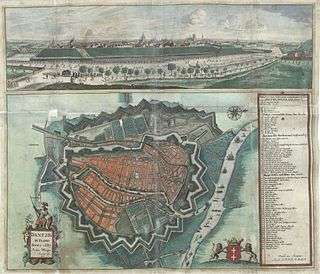
Historical affiliations
![]()
![]()
![]()
![]()
![]()
![]()
![]()
![]()
![]()
![]()
![]()
![]()
![]()
![]()
![]()
After World War I the Free City of Danzig was created, a city-state under the supervision of the League of Nations. The German attack on the Polish military depot at Westerplatte marks the start of World War II and the city was annexed by Nazi Germany in 1939. Local Jews were systematically murdered in the Holocaust while Poles and Kashubians also faced persecution. After World War II the city became part of Poland and the city's German inhabitants, that had constituted the majority of the city's mixed population before the war, either fled or were expelled to Germany. During post-1945 era, the city was rebuilt from war damage, and vast shipyards were constructed. The centre of Solidarity strikes in the 1980s, after abolishment of communism in 1989 its population faced poverty and large unemployment with most of the ship building industry closed down.
History
Early times
The area around the Vistula delta was inhabited by populations belonging to the various archaeological cultures of the Stone Age, Bronze Age, and Iron Age. Settlements existed in the area for several centuries BC.
Foundation in early Polish state
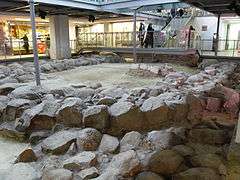
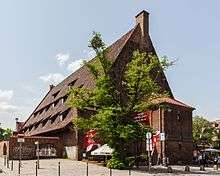
Most likely Mieszko I of Poland founded the town in the 980s, thereby connecting the Polish state ruled by the Piast dynasty with the trade routes of the Baltic Sea.[1] The earliest traces of medieval settlement were discovered in an area now occupied by the town hall of the Main Town,[2] on top of archaeological remains from the Roman Iron Age.[3] The oldest constructions of this settlement were built, according to dendrochronology, with timber from trees cut in 930.[4] The immediate western vicinity of the town hall has, however, so far not been surveyed, thus it can not be excluded that the settlement extended further to the west.[5] Dendrodates exclusively refer to the 10th century, no constructions from the 11th century were found.[4] The very beginning of Gdańsk is related to the fall of Truso in the second half of the 10th century - the Viking Age Emporium situated on eastern side of the Vistula delta. Only after this town declined, it was eclipsed as a trade centre by nearby Gdańsk.[6]
In the area south of the current St. Nicholas church, settlement started some years later. The oldest constructions there were dated by finds of pottery to either the second half of the 10th century or the turn of the 10th to the 11th century.[5] The first written record thought to refer to Gdańsk is the vita of Saint Adalbert: Written in 999, it describes how in 997 Saint Adalbert of Prague baptized the inhabitants of urbs Gyddannyzc, "which separated the great realm of the duke from the sea."[7] No further written sources exist for the 10th and 11th centuries.[7]
In the area of the current Great Mill the oldest settlement layers were dated by finds of pottery to the 11th century or the turn of the 12th.[5] Though the area between St. Nicholas Church and the Great Mill has not yet been sufficiently surveyed, it has been suggested by Paner that in the course of the 11th century the settlement just south of St. Nicholas was expanded to the northwest to reach the vicinity of the Great Mill and, possibly, the area around St. Catherine church.[5] In the northern vicinity of St. Nicholas, in the area of the current market hall, settlement then started probably in the 12th century.[5] As of 2004, archaeologists have not been able to find traces of fortifications around the before mentioned settlement(s).[5]
Slightly east of the Great Mill, at the banks of the Motława river, a stronghold was built in the 1060s.[8] This stronghold encompassed roughly the area now enclosed by the Rycerska and Sukiennicza streets, and in the 11th century was located at the confluence of the Motława and Vistula rivers.[9] The stronghold consisted of a fort and a suburbium covering 2.7 ha which may have held 2,200 to 2,500 inhabitants.[10] Timber from trees cut between 1054 and 1063 was used for buildings of the first phase of the stronghold's construction, timber from trees cut around 1090 was used to construct the buildings of the subsequent phase.[8] A first rampart enclosing the stronghold was built with timber from trees cut in the 1060s.[8] Starting in 1112, according to dendrodates, the stronghold was first leveled and subsequently transformed.[8] This corresponds with written sources mentioning the subduction of Pomerelia by Piast Polish king Boleslaw III Wrymouth between 1112 and 1116.[11] The youngest examined layers from which dendrodates could be derived point at around 1135.[8]
Starting in the mid-12th and throughout the 13th centuries, the settlement west of the stronghold greatly expanded northwards to comprise the wider area around present-day Rajska and Podbielanska streets in the Old Town.[12] In the southern part of the settlement, in the area now occupied by the market hall, a Romanesque St. Nicholas church was built in the second half of the 12th century, which according to Paner "was probably the second masonry church in Gdansk, after the stronghold's church"[3] and was replaced by another Romanesque St. Nicholas church built in 1223-1241 by the Dominicans, who owned the area since 1227.[13] In 1168, the Cistercians built a monastery in nearby Oliva (northwest of the town) which is inside the modern city limits. A parochial St. Catherine church is first mentioned in written records in the second half of the 13th century, situated in the new centre of the expanded settlement.[14]
Historical population
of Gdańsk/Danzig
| c. 1000 | 1000 | |
| 1235 | 2,000 | |
| 1600 | 40,000 | |
| 1650 | 70,000 | |
| 1700 | 50,000 | |
| 1750 | 46,000 | |
| 1793 | 36,000 | |
| 1800 | 48,000 | |
| 1825 | 61,900 | |
| 1840 | 65,000 | |
| 1852 | 67,000 | |
| 1874 | 90,500 | |
| 1880 | 13,701 | |
| 1885 | 108,500 | |
| 1900 | 140,600 | |
| 1910 | 170,300 | |
| 1920 | 360,000 (whole FCD) | |
| 1925 | 210,300 | |
| 1939 | 250,000 | |
| 1946 | 118,000 | |
| 1950 | ? | |
| 1960 | 286,900 | |
| 1970 | 365,600 | |
| 1975 | 421,000 | |
| 1980 | 456,700 | |
| 1990 | ? | |
| 1994 | 464,000 | |
| 2000 | ? | |
| 2002 | 460,000 |
Compare: population of Tricity, Poland
Capital of a Pomerelian Duchy (1215–1271)
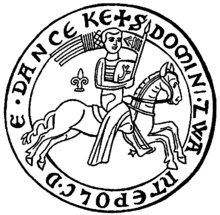
At the end of the 11th century Poland lost control over Pomerelia and did not regain it until the 12th century. Soon after Poland itself was divided into several autonomous provinces formally under the overlordship of the High-Duke of Kraków. The Pomerelian duchies remained under the control of stewards, of the Samborides dynasty, appointed by Polish Dukes, usually those of Greater Poland, although like other Polish provinces during the period of feudal partitions of Poland it increased its regional autonomy. Gdańsk was the main stronghold of Samborides, serving as residence of Mestwin I (1207–1220) Swantopolk II (1215–1266) and Mestwin II (1271–1294).
Around 1235 the settlement had some 2,000 inhabitants and was granted Lübeck city rights by Swantopolk II. Merchants from the Hanseatic cities of Lübeck and Bremen began to settle in the town after 1257, although a significant German population was not present until the 14th century. Officially chartered as a city in 1224, it rose to become one of the more important trading and fishing ports along the Baltic Sea coast. However, in 1282/1294 Mestwin II, the last duke of Pomerelia, ceded all his lands including Gdańsk to Duke of Greater Poland Przemysł II. Przemysł's official title as a result became "dux Polonie et Pomoranie". After Przemysł's assassination in 1296, the city was temporary ruled by the kings of Bohemia and Poland, Wenceslaus II and his son Wenceslaus III.
Monastic State of the Teutonic Knights (1308–1454)
At the beginning of the 14th century, the region was plunged into war involving Poland and the Margraviate of Brandenburg. Because King Władysław I of Poland's troops were unable to relieve Gdańsk from a siege by Brandenburg, the city's Pomeranian judge, Bogusza, appealed to the Teutonic Knights of the Teutonic Monastic State of Prussia for assistance.[15] The Knights expelled the Brandenburgers in 1308, but did not relinquish the city to Poland. The townspeople rebelled in an uprising bloodily repressed by the Knights. The royal garrison was attacked and expelled[16] and the suburban populace was slaughtered, with the suburbs subsequently destroyed.[15] Gdańsk's colony of German merchants and artisans was specifically attacked because they competed with the Knights' town of Elbing (Elbląg), a nearby city.[17] Polish reports claimed that 10,000 inhabitants were slain in the city.[18] Although that number has been subject of debate among historians, a consensus has been established that many people were murdered and a considerable part of the town was destroyed in the context of the take-over.[17]
The Knights then captured the rest of Pomerelia from Brandenburg's troops. In September 1309, Margrave Waldemar of Brandenburg-Stendal sold his claim to the territory to the Teutonic Order for 10,000 marks, thereby connecting the Order's territory with that of the Holy Roman Empire. Danzig was incorporated into the Monastic State of the Teutonic Knights. Previously allies against the Baltic tribe of the Old Prussians, Poland and the Teutonic Order engaged in a series of Polish-Teutonic Wars after the Knights' capture of Pomerelia.
Between 1361 and 1416 the city's burghers rose in several armed revolts against the rule of the Teutonic Knights. In 1410, during the Polish–Lithuanian–Teutonic War the city's council recognized the Polish king, Władysław Jagiełło as its sovereign. After the end of the war, concluded with the Peace of Toruń in 1411, Jagiełło relieved the city of its oath of fealty and it reverted to Teutonic rule. Subsequently, the town's populace was repressed by the German knights as punishment for its support of the Polish king.
Development of the city initially stagnated after its capture by the Teutonic Knights. The new rulers tried to reduce the economic significance of Danzig by abolishing the local government and the privileges of the town's traders. This was exemplified by the fact that the Danzig city council, including Arnold Hecht and Conrad Letzkau, was removed and its leaders beheaded in 1411. Later on, the German knights had to accept the fact that Danzig defended its independence and was the largest and most important seaport of the region after overtaking Elbing. Subsequently, Danzig flourished, benefiting from major investment and economic prosperity in the Teutonic Prussia and Poland, which stimulated trade along the Vistula. The city had become a full member of the Hanseatic League by 1361, but its merchants remained resentful at the barriers to the trade up the Vistula river to Poland, along with the lack of political rights in a state ruled in the interest of the Order's religiously motivated knight-monks.
The takeover of Danzig by the Teutonic Order was questioned consistently by the Polish kings Władysław and Casimir the Great, which led to a series of bloody wars and legal suits in the papal court in 1320 and 1333. Peace was established in the Treaty of Kalisz in 1343; although the Polish kings were able to retain the title "Duke of Pomerania" and were recognized as titular overlords of the crusaders, the Knights retained control of Danzig for the time being.[15]
As part of the Kingdom of Poland (1454/66–1793)
In 1440, Danzig joined the nearby Hanseatic cities of Elbing and Thorn (Toruń) to form the Prussian Confederation, which in February 1454 seceded from the Teutonic Order's rule and recognized the suzerainty of King Casimir IV of Poland.
On 10 February 1454 a delegation of Prussian Confederation submitted a petition to the Polish king asking him to regain power over Prussia as the rightful ruler. An "Act of Incorporation of Royal Prussia" was signed in Cracow (6 March 1454), recognizing Pomerelia as part[19] of the Polish Kingdom. The resulting Thirteen Years' War ended in 1466 with the Order's defeat. With the Second Peace of Thorn (1466), Pomerelia and the rest of the area became a province of Poland called Royal Prussia. The 15th and 16th centuries brought changes to the city's cultural heritage. They could be seen in the arts and language, as well as Danzig's contributions to the world of science. In 1471, a refurbished sailing ship under the native Danzig captain Paul Beneke brought the famous altar painting titled Jüngstes Gericht (Last Judgement) by artist Hans Memling to Danzig. Around 1480–1490, tablets were installed at St. Mary's Church, depicting the Ten Commandments in Middle Low German.[20]
In 1520 Lutheran Scriptures were printed, in 1522 the first Lutheran liturgy was held by the local cleric Jakob Hegge and the Protestant Reformation was soon supported by the local populace. In 1523 some iconoclastic riots occurred and the towncouncil was deposed. This revolt was quelled in 1524 by Polish troops and the leaders were executed or imprisoned, some of them released and exiled to the Protestant Duchy of Prussia on request of Albert of Prussia. While the city ordinance of 1526 penalized the Lutheran liturgy under death penalty, the burghers were still influenced by reformatory ideas. In 1557 the Lutheran Eucharist was permitted and both religious orientations were tolerated.[21]
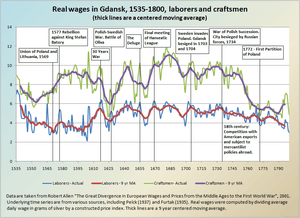
Georg Joachim Rheticus visited the mayor of Danzig in 1539, while he was working with Nicolaus Copernicus in nearby Frauenburg (Frombork). The mayor of Danzig gave Rheticus financial assistance for the publication of the Narratio Prima, published by the Danzig printer Franz Rhode in 1540 and to this day considered the best introduction to the Copernican theory. While in Danzig, Rheticus, who was also a cartographer and navigational instrument maker, interviewed Danzig sailors as to their navigational needs. He presented the Tabula chorographica auff Preusse to Duke Albert of Prussia in 1541.
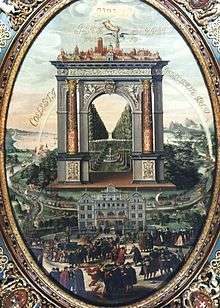
From 1563, for over a century, the post of town master builder was held by architects from the Netherlands.[22] Entire streets were designed in Dutch Renaissance style.[23]
In 1566, the official language of the city's governing institutions was changed from Middle Low German, which had been used throughout the Hanseatic cities, to standard German, used in most German courts. The Polish language was taught in local Academic Gymnasium (Grammar School or High School)[24] from 1589.[25]
In the 16th century Gdańsk was the largest and one of the most influential cities of Poland and had a preponderantly German population. [26]. The city enjoyed voting rights during the free election period.
During the Danzig rebellion the city was besieged for six months in 1577 by the forces of King Stephen Báthory. With the Royal army unable to capture the city and the Danzig forces failing to lift the siege a settlement was negotiated in which Báthory confirmed the city's special status and her Danzig law privileges and the city recognised him as ruler of the Commonwealth and paid him a large sum of 200,000 złotys.
In 1606 a distillery named Der Lachs (German for "the Salmon") was founded, which produced one of Danzig's most famous products, a liqueur named Danziger Goldwasser.
The Danzig printer Andreas, Freiherr von Hünefeld(t) (Hunsfeldus) (1606–1652) printed a Danzig edition of the Rosicrucian Manifestos. Later on, he published the poems of Martin Opitz. Opitz had died in 1639 and his friend, Pastor Bartholomaeus Nigrinus of Danzig, together with two associates edited the Opitz poems for the Hünefeld printing house. Polish private schools were opened in addition to public schools who taught Polish during this period with 1370 Polish students in later half of the 17th century.[27][28]
From the 14th century until the mid-17th century Danzig experienced rapid growth, becoming by the 16th century the largest city on the Baltic seaboard, owing to its large trade with the Netherlands and its handling of most of Poland's seaborne trade, transported northward via the Vistula River. The city's prosperity was severely restricted, however, by the Thirty Years' War (1618–1648) and the Northern Wars (1655–1660), and it suffered an epidemic of bubonic plague in 1709. In 1654, Charles X Gustav of Sweden invaded Poland; in 1655 he appeared outside the Danzig city walls, but refrained from laying siege. A Dutch fleet arrived in July 1656, reopening the vital trade with the Netherlands.
In 1650 87 percent of the populace were Lutheran, 6 percent Calvinists and about 7 percent Catholics, a number that would grow to more than 20 percent in 1800 due to the migration of Catholics from the vicinity.[29] A large share of the Lutheran population used Polish as their language[30] and Poles played an influential role in the Lutheran Church in Royal Prussia.[31]
Danzig took part in all Hanseatic League conferences until the final one in 1669. By that time the United Provinces and other long-distance overseas commercial powers had surpassed the Baltic trade centres such as Danzig. In 1734, the city was briefly occupied by the Russians under Field Marshal Munnich after the prolonged Siege of Danzig during the War of the Polish Succession. The city, which supported Stanisław Leszczyński, the losing candidate for the throne, was forced to pay reparations following the siege.
In 1743 the Danzig Research Society was formed by Daniel Gralath and Gottfried Lengnich.
In the Kingdom of Prussia (1793–1806)
During the First Partition of Poland in 1772, the inhabitants of Danzig fought fiercely for it to remain a part of Poland,[32] although the majority of Royal Prussia fell to the Kingdom of Prussia. For several years Danzig was surrounded by Prussian territories. In 1793 it was captured by Prussian forces and incorporated into the Prussian Kingdom as part of the province of West Prussia. According to Peter Oliver Loew (2011) the common language in Danzig until the partition was German and the knowledge of German was the premise to become an integrated burgher,[33][34] however, according to Maria Babnis (1989) the majority of the population in the city spoke both Polish and German and spoken language didn't determine national identity.[35] After the partition the city's inhabitants demonstrated their resentment towards Prussia, with some, like Arthur Schopenhauer's family, choosing emigration.[36] An attempt of student uprising against Prussia led by Gottfried Benjamin Bartholdi was crushed quickly by the authorities in 1797.[37][38][39] The migration processes that happened after Prussia took over the city diminished the usage of Polish language and structure of population.[40]
Napoleonic Free City of Danzig
After the defeat of the Fourth Coalition, and the capture of the city by French troops, Napoleon Bonaparte created the semi-independent Free City of Danzig (1807–1814). Danzig reverted to Prussia after Napoleon's defeat in 1814, following another siege that lasted almost a whole year. The city became the capital of Regierungsbezirk Danzig within West Prussia in 1815.
In the Kingdom of Prussia (1815–1919)
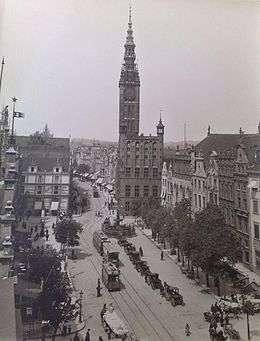
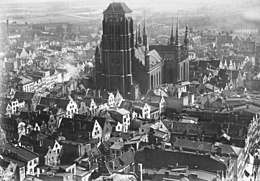
In 1816 about 70 percent of the populace were Lutheran, 23.6 percent Catholics, the share of Catholics would grow to 33 percent in 1910.[41]
With the Industrial Revolution and the steam engine trains, industrial machinery and Ferdinand Schichau's Schichau-Werke company gained the upper hand for Elbing over Danzig. Schichau later constructed a large shipyard in Danzig as well, however.
From 1824 until 1878, East and West Prussia were combined as a single province within the Prussian Kingdom. As a part of Prussia Danzig was a member of the Zollverein and elected its representatives to the German National Assembly of 1848,[42] but lay outside of the borders of the 1815–1866 German Confederation. In the second half of the 19th century the growth of German population in the city was being slowly reversed, with more Poles settling in, mainly from Pomerania, and parts of local population discovering their Polish roots[43]
In 1871 the city was included in the newly created German Empire. The Polish minority in the city started its activities in the late 1870s and 1880s with the creation of a Polish organisation Ogniwo and formation of a Polish bank Bank Bałtycki.[36] In 1891 a Polish newspaper Gazeta Gdańska was printed out, and later two publishing houses and a printing press.[36] Local Poles focused their cultural life in the vicinity of Church of Saint Anna.[36]
In 1907 local Poles from the "Straż" movement, organised protests against Prussian policies of Germanization, including a ban on Polish language and expropriation of Polish home owners[44]
Free City (1920–1939)
Following Germany's defeat in World War I, the Allied powers in the Treaty of Versailles (1919) decided to create the Free City of Danzig (under a commissioner appointed by the League of Nations) covering the city itself, the seaport, and a substantial surrounding territory. The League of Nations rejected the citizens' petition to have their city officially named as the Free Hanseatic city of Danzig (Freie Hansestadt Danzig).[45] The citizens of Danzig received a separate citizenship of the Free City and thus lost their former German citizenship.
According to the official census of 1923 3.7 percent of city population was Polish (13,656 out of 366,730 citizens of the Free City) and in the 1920s and 1930s the city's population was over 90% German.[46][47] However Polish claims range up to around 22.000, or around 6% of the population, and increased to around 13% in the 1930s.[48] Other estimates give the number of Poles as 17% in the whole area of the Free City[49] In the elections to the Free City of Danzig's Parliament the results of Polish Parties declined from 6.08 percent of votes in 1919 to 3.15 in 1927 and 3.53 in 1935. According to Henryk Stępniak many Poles voted for the Catholic Zentrumspartei instead[50] and, based on these assumed voting patterns, he estimates the number of Poles in the city to be 25-30% of Catholics living within it or about 30-36 thousand people. In addition around 4,000 Polish nationals were registered in the city, bringing the total number of Polish population to 9.4-11% of people in this estimate.[51] According to other estimates about 10 percent of the 130,000 Catholics were Polish.[52] Piotr Mickiewicz claims, the city authorities were made up of former Prussian officials who were hostile to Poland and Poles[53] According to Artur Hutnikiewicz the Polish population faced discrimination and persecution in the Free City, which it tried to resist.[54] Poles faced discrimination from German officials in employment and in education[55] This constituted violation of international laws, which obliged the city to treat Poles equally to Germans[56]
The Free City of Danzig issued its own stamps and currency (the Gulden). Many examples of stamps and coins, bearing the legend Freie Stadt Danzig, survive in collections.
The strategic aim of Poland was to gain free access to the open sea, and the territories assigned to Poland in the Treaty of Versailles provided a good opportunity to do so. However, during the Polish-Soviet War, Danzig workers went on strike to block delivery of ammunition to the Polish army when the Soviet Red Army tried to capture Warsaw. The Second Polish Republic then built a military transit depot with a small squad of troops at Westerplatte.
A customs union with Poland was created by the victorious allies of World War I. The separation of the Danzig port, post office and customs office under the treaty was said to be justified by Poland's need for direct access to the Baltic Sea. Due to the massive resentment by the Danzigers and with large foreign investments, Poland began building a large military port in Gdynia, just 25 km (16 miles) away from Danzig. Unlike Danzig, Gdynia was in the direct possession of Poland and soon became the so-called "Polish outside window".
Due to a German-Polish customs war between 1925 and 1934, Poland became focused on international trade; for example, a new railway line was built to connect Silesia with the coast and the new tariffs made it cheaper to send goods through Polish ports rather than German ones. Gdynia became the biggest port on the Baltic sea. Nevertheless, Poland resorted to economic sanctions during the Danzig-Polish conflicts and Danzig suffered greatly. There was a strong desire to rescind the Allied Powers' decision on the status of the city's 400,000 citizens which were predominantly German. This culminated in the election of a National Socialist government in Danzig's elections in May 1933.
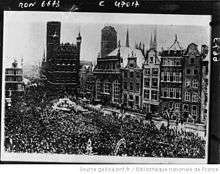
The German incorporation of Danzig was a territorial claim that every government of the Weimar Republic put on its agenda.
A German–Polish Non-Aggression Pact was signed and the Free City's government was ordered by the Nazis to stop making problems between Poland and Danzig. Poland and Danzig entered a brief period of good economic cooperation and prosperity. Nevertheless, a totalitarian society was being constructed in Germany, and especially members of the Polish or Jewish minority required stamina in the face of everyday acts of violence and persecution from the Nazis.
About 50 percent of members of the Jewish Community of Danzig had left the city within a year after a pogrom in October 1937,[57] after the Kristallnacht riots in November 1938 the community decided to organize its emigration[58] and in March 1939 a first transport to Mandate Palestine started.[59] By September 1939 barely 1,700 mostly elderly Jews remained. In early 1941 just 600 Jews were still living in Danzig who were later deported to the ghetto in Warsaw or to Theresienstadt.[57][60] The majority of them were later sent to various extermination camps.[61] Out of the 2938 Jewish community in the city 1227 were able to escape from the Nazis before the outbreak of war[62]
World War II (1939–1945)
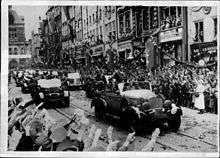
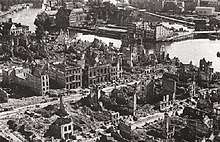
Following the annexation of Austria and the Sudetenland, Germany in October 1938 urged the Danzig territory's cession to Germany. On 1 September 1939 Nazi Germany invaded Poland, initiating World War II. On 2 September 1939 Germany officially annexed the Free City. The Nazi regime murdered the Polish postmen defending the Polish Post Office: this was one of the first war crimes during the war. Other Polish soldiers defending the Westerplatte stronghold surrendered after seven days of fighting. The German commander returned the sword to the Polish commander for putting up a brave fight, while the same time one the captured defenders, Kazimierz Rasinski was brutally tortured by Germans and murdered when he refused to reveal Polish communication codes.[63] On Sep 7th NSDAP organised night parade on Adolf-Hitlerstrasse to celebrate success. It was bombed by a single Polish hydroplane operating from Hela peninsula piloted by Jozef Rudzki and Zdzisław Juszczakiewicz. Six bombs each weighing 12.5 kg (28 lb) were dropped from very low height.[64] In October 1939, Danzig, together with the prewar Pomeranian Voivodship to the south and west, became the German Reichsgau (administrative district) of Danzig-West Prussia (Danzig–Westpreussen). With the start of the war the Nazi regime began its policy of extermination in Pomerania; Poles, Kashubians and Jews[65] and the political opposition[66] were sent to concentration camps, especially neighbouring Stutthof where 85,000 victims perished. Kashubian and Polish intelligentsia were killed in the Piaśnica mass murder site, which is estimated to have had 60,000 victims.
In the city itself hundreds of prisoners were subjected to cruel Nazi executions and experiments, which included castration of men and sterilization of women considered dangerous to the "purity of Nordic race" and beheading by guillotine[67] The courts and judicial system in the annexed territories of Nazi Germany was one of the main ways to legislate an extermination policy against ethnic Poles, terminology in the courts was full of statements such as "Polish subhumans" and "Polish rabble".[68][69] Some judges even declared that Poles were to have tougher sentences than Germans because of their alleged racial inferiority.[69]
At the beginning of 1945, facing the imminent fall of the Nazi State, Germany started evacuating civilians from Danzig. Most Germans fled the city, many by seaborne evacuation to Schleswig-Holstein. This happened in winter under the threat of bombs and in constant danger of submarines.
On 30 March 1945 the Soviet Red Army occupied a largely destroyed Danzig. The exact circumstances of the occupation remain a matter of dispute. While the traditional Polish historiography stressed the role of the German resistance, after 1990 reports about deliberate destructions and arsons by the Soviets were published. However, as Soviet sources about the events are inaccessible, the topic has not been conclusively clarified.[70] In December 1945 the Soviet Consulate explained the existing "anti-Soviet feelings" with some "excesses" of the Red Army.[71]
In June 1945 124,000 Germans and 8,000 Poles lived in the city,[72] from 1945 to 1950 most Germans were expelled.
Post-World War II
.jpg)
With the German defeat the planned genocide of the Polish population, who were deemed by the German authorities to be "subhuman," was averted and Poles returned to Gdańsk.[73][74][75]
Already before the end of World War II, the Yalta Conference had agreed to place the city, under Polish name Gdańsk, under de facto administration of Poland, and this decision was confirmed at the Potsdam Conference.[76][77][78]
A Polish administration was set up in the devastated Gdańsk on 30 March 1945. New Polish residents were settled in Gdańsk, 3,200 in April and more than 4,000 in May and June 1945. As of 1948 more than two thirds of the 150,000 inhabitants came from Central Poland, about 15 to 18 percent from Polish-speaking areas east of the Curzon Line that were annexed by the Soviet Union after World War II. Many local Kashubians also moved into the city. The deportation of the German populace started in July 1945, thus the pre-war populace soon became a small minority within post-war Gdańsk.[79]
The members of the pre-war Polish minority in the city organized associations dedicated to upholding their past traditions and history; the first one being Związek Weteranów Walk o Polskość Gdańska i Wybrzeża. In the following years additional ones were founded like Towarzystwo Przyjaciół Gdańska which continues its work to this day.[80]
Between 1952 and the late 1960s Polish artisans restored much of the old city's architecture, up to 90% destroyed in the war.[81] Initially the reconstruction of parts of the inner city (Główne Miasto, German: Rechtstadt) was controversial. As a result of anti-German sentiments and the new settlers' at least indifferent attitude towards the unknown, German city a modern architecture was preferred.[82] The decision to reconstruct a traditional old town was politically motivated in order to symbolize the city's "reunification" with Poland[82] and limited to the area of the Główne Miasto. The Old town and other historical districts were, with the exception of some monumental buildings, built-up with modern architecture.[83] The reconstruction is not tied to the city's pre-war appearance, instead its purpose was to rebuild an idealized pre-1793 state.[84][85] 19th and early 20th-century architecture, any traces of German tradition were ignored or regarded as "Prussian barbarism" worth of demolition[86][87] while Flemish-Dutch, Italian and French influences were emphasized.[88] After 1990 this concept has been criticized by Donald Tusk, who called the reconstruction "in the spirit of Communism" the city's second catastrophe of the 20th century.[89] All German names of streets, buildings, shipyards and districts, even names on tombstones, were changed to Polish names, such as Długi Targ for Langer Markt (Long Market), the city's main pedestrian center. The city districts were renamed, sometimes derived from medieval Polish records (Wrzeszcz, Siedlce), sometimes translations of the German terms (Nowy Szkoty - Neu Schottland, Nowy Port - Neufahrwasser). In some cases the specifications of the Commission for the Determination of Place Names were initially ignored and place names originating in the home region of the settlers were used.[90]
Gdańsk was the scene of anti-government demonstrations which led to the downfall of Poland's communist leader Władysław Gomułka in December 1970, and ten years later was the birthplace of the Solidarity trade union movement, whose opposition to the government helped end of communist party rule in 1989 and the election as president of Poland of its leader Lech Wałęsa. It remains today a major port and industrial city.
A list of the 173 mayors of the City of Danzig from 1347 to March 1945 was compiled by the current Gdańsk city government and can be found on their recent website with the invitation for the "First World Gdańsk Reunion", which took place in May 2002. This list demonstrates the violently shifting ethnicity of the city's inhabitants before and after the World Wars.[91]
Famous people born in the city
- List of people from Gdańsk
- List of mayors of Gdańsk
- List of mayors of Danzig
- Johannes Dantiscus, 1485, poet, diplomat, church canon and bishop
- Bernhard von Reesen, 1490
- Albrecht Giese, 1524
- Johannes Hevelius, 1611, astronomer
- Georg Daniel Schultz, 1615
- Andreas Schlüter, 1660
- Jacob Theodor Klein, 1685
- Daniel Gabriel Fahrenheit, 1686–1736, physicist and engineer
- Daniel Gralath, 1708, physicist and Bürgermeister (mayor)
- Louise Adelgunde Gottsched, 1713, writer
- Daniel Chodowiecki, 1726, painter
- Johann Wilhelm Archenholz, 1741
- Avraham Danzig, 1748, rabbi
- Georg Forster, 1754
- Gottlieb Hufeland. 1760
- Johanna Schopenhauer, 1766
- Johannes Daniel Falk, 1768
- Arthur Schopenhauer, 1788
- Miltiades Caridis 1923-1998
- Günter Grass, b. 1927–2015, writer and philosopher
- Paweł Huelle, b 1957, writer and journalist
- Donald Tusk, b. 1957, politician, journalist and historian, prime minister of Poland
- Dariusz Michalczewski, b. 1968, boxer
Famous people living or working in the city
- Edward O'Rourke, the first bishop of the Diocese of Danzig
- Lech Wałęsa, b. 1943, trade unions activist, politician, president of Poland (1990–1995)
- Stanisław Pestka, b. 1929 in Rolbik - Kashubian poet
- Robert Gordon b. 1668, d. 1731, Merchant and philanthropist
See also
- Timeline of Gdańsk history
- List of Gdańsk aristocratic families
- Lists of Danzig officials
- List of mayors of Danzig
References
- Hess, Corina (2007). Danziger Wohnkultur in der frühen Neuzeit. Berlin-Hamburg-Münster: LIT Verlag. p. 39. ISBN 3-8258-8711-1.
- Paner, Henryk (2004). "The spatial development of Gdańsk to the beginning of the 14th century. The origins of the Old and Main Town". In Przemysław Urbańczyk (ed.). Polish lands at the turn of the first and the second millennia. Warsaw. pp. 15–32, esp. p. 18.
- Paner, Henryk (2004). "The spatial development of Gdańsk to the beginning of the 14th century. The origins of the Old and Main Town". In Przemysław Urbańczyk (ed.). Polish lands at the turn of the first and the second millennia. Warsaw. pp. 15–32, esp. p. 23.
- Paner, Henryk (2004). "The spatial development of Gdańsk to the beginning of the 14th century. The origins of the Old and Main Town". In Przemysław Urbańczyk (ed.). Polish lands at the turn of the first and the second millennia. Warsaw. pp. 15–32, esp. p. 19.
- Paner, Henryk (2004). "The spatial development of Gdańsk to the beginning of the 14th century. The origins of the Old and Main Town". In Przemysław Urbańczyk (ed.). Polish lands at the turn of the first and the second millennia. Warsaw. pp. 15–32, esp. p. 20.
- Bogucki, Mateusz (2004). "Viking age trade ports in Poland". Estonian Journal of Archaeology. 8 (2): 100–127.
- Loew, Peter Oliver: Danzig. Biographie einer Stadt, Munich 2011, p. 24.
- Paner, Henryk (2004). "The spatial development of Gdańsk to the beginning of the 14th century. The origins of the Old and Main Town". In Przemysław Urbańczyk (ed.). Polish lands at the turn of the first and the second millennia. Warsaw. pp. 15–32, esp. p. 21.
- Paner, Henryk (2004). "The spatial development of Gdańsk to the beginning of the 14th century. The origins of the Old and Main Town". In Przemysław Urbańczyk (ed.). Polish lands at the turn of the first and the second millennia. Warsaw. pp. 15–32, esp. pp. 17, 19.
- Loew, Peter Oliver: Danzig. Biographie einer Stadt, Munich 2011, p. 27.
- Piskorski, Jan Maria (1999). Pommern im Wandel der Zeiten. Szczecin/Stettin. p. 36.
- Paner, Henryk (2004). "The spatial development of Gdańsk to the beginning of the 14th century. The origins of the Old and Main Town". In Przemysław Urbańczyk (ed.). Polish lands at the turn of the first and the second millennia. Warsaw. pp. 15–32, esp. pp. 21-22.
- Paner, Henryk (2004). "The spatial development of Gdańsk to the beginning of the 14th century. The origins of the Old and Main Town". In Przemysław Urbańczyk (ed.). Polish lands at the turn of the first and the second millennia. Warsaw. pp. 15–32, esp. p. 24.
- Paner, Henryk (2004). "The spatial development of Gdańsk to the beginning of the 14th century. The origins of the Old and Main Town". In Przemysław Urbańczyk (ed.). Polish lands at the turn of the first and the second millennia. Warsaw. pp. 15–32, esp. pp. 28-29.
- Gieysztor, Alexander, Stefan Kieniewicz, Emanuel Rostworowski, Janusz Tazbir, and Henryk Wereszycki. History of Poland. PWN. Warsaw, 1979. ISBN 83-01-00392-8
- Halecki, Oscar. A History of Poland. Roy Publishers. New York, 1976. ISBN 0-679-51087-7
- Urban, William. The Teutonic Knights: A Military History. Greenhill Books. London, 2003. ISBN 1-85367-535-0
- Urban, Thomas. "Rezydencja książąt Pomorskich Archived 2005-08-25 at the Wayback Machine". (in Polish)
- F. Kiryk, J. Ryś, Wielka Historia polski, t. II, 1320-1506, Kraków 1997, p. 160-161.
- "Table of the Ten Commandments". Web.archive.org. 2007-09-27. Archived from the original on 2007-09-27. Retrieved 2009-07-26.
- Hartmut Boockmann, Ostpreussen und Westpreussen, Siedler 2002, p. 269-273, ISBN 3-88680-212-4
- Roding, Juliette (1996). "The North Sea coasts, architectural unity?". The North Sea and Culture (1550-1800): Proceedings of the International Conference Held at Leiden 21-22 April 1995. Uitgeverij Verloren. p. 102.
- Frijhoff, Willem; Spies, Marijke (2004). Dutch Culture in a European Perspective. Vol. 1. 1650: Hard-won unity. Royal Van Gorcum. p. 134.
- http://dict.tu-chemnitz.de; search Gymnasium
- Polszczyzna regionalna Pomorza:zbiór studiów, Tom 6 Regina Pawłowska Nauczanie jęzka polskiego w Gdańsku w XVII wieku Kwiryna Handke, Instytut Słowianoznawstwa (Polska Akademia Nauk) Zakład Narodowy im. Ossolińskich, 1994 page 43
- Zamoyski, Adam (2015). Poland. A History. William Collins. pp. 26, 92. ISBN 978-0007556212.
- Metodyka nauczania języka polskiego jako obcegoJan Lewandowski Państwowe Wydawnictwo Naukowe, page 23 1980
- Z dziejów języka polskiego w GdańskuRegina Jefimow page 5 Wydawnictwo Morskie 1970
- Loew, Peter Oliver (2011). Danzig - Biographie einer Stadt (in German). C.H. Beck. pp. 90, 131. ISBN 3406605877.
- Pomorze w dziejach Polski, Hanna Kościelecka Gdańskie Towarzystwo Naukowe, Wydział I Nauk Społecznych i Humanistycznych, page 139, 1991
- "Od Prus Książęcych do Królestwa Pruskiego", Stanisław Salmonowicz, 70 Towarzystwo Naukowe Imienia Wojciecha Ketrzyńskiego, 1992
- Gdańsk i Ziemia Gdańska Franciszek Mamuszka Wiedza Powszechna, 1966 page 83
- Loew, Peter Oliver (2011). Danzig - Biographie einer Stadt (in German). C.H. Beck. pp. 44, 89. ISBN 3406605877.
- Waissenberger, Robert (1982). Die Türken vor Wien (in German). Residenzverlag. p. 60. ISBN 3701703124.
- Książka polska w Gdańsku w okresie zaboru pruskiego 1793-1919, page 6, Maria Babnis, Ossolineum, 1989
- Historia Polski 1795-1815 Andrzej Chwalba Kraków 2000 page 441
- Dzieje Gdańska Edmund Cieślak, Czesław Biernat Wydawn. Morskie, 1969 page 370
- Dzieje Polski w datach Jerzy Borowiec, Halina Niemiec page 161
- Polska, losy państwa i narodu Henryk Samsonowicz 1992 Iskry page 282
- Książka polska w Gdańsku w okresie zaboru pruskiego 1793-1919, page 61 Maria Babnis, Ossolineum 1989
- Loew, Peter Oliver (2011). Danzig - Biographie einer Stadt (in German). C.H. Beck. p. 172. ISBN 3406605877.
- Best, Heinrich; Weege, Wilhelm (1998). Biographisches Handbuch der Abgeordneten der Frankfurter Nationalversammlung 1848/49. Düsseldorf: Droste Verlag. ISBN 3-7700-0919-3.
- Dzieje Gdańska,page 261, Edmund Cieślak, Czesław Biernat, Wydawnictwo Morskie, 1969
- "Polskie organizacje na Pomorzu Gdańskim w latach 1871-1914: działalność w służbie oświaty, wychowania i kultury", page 89, Teresa Wróblewska Państwowe Wydawnictwo Naukowe, 1989
- Loew, Peter Oliver (2011). Danzig - Biographie einer Stadt (in German). C.H. Beck. p. 188. ISBN 3406605877.
- John Brown Mason (1946). The Danzig Dilemma: A Study in Peacemaking by Compromise. Stanford University Press. pp. 5–6.
- It was 96.5% German says Catherine Epstein (2012). Model Nazi: Arthur Greiser and the Occupation of Western Poland. Oxford U.P. p. 39.
- Zapiski historyczne: Volume 60, page 256, Towarzystwo Naukowe w Toruniu. Wydział Nauk Historycznych - 1995
- Studia polonijne, Volume 23, page 239, Mieczysław Albert Krąpiec, Towarzystwo Naukowe Katolickiego Uniwersytetu Lubelskiego, 2002
- Ludność polska w Wolnym Mieście Gdańsku, 1920-1939, page 37, Henryk Stępniak, Wydawnictwo "Stella Maris", 1991
- Ludność polska w Wolnym Mieście Gdańsku, 1920-1939, page 37, Henryk Stępniak, Wydawnictwo "Stella Maris", 1991"Przyjmując, że Polacy gdańscy stanowili 25 — 30% ogólnej liczby ludności katolickiej Wolnego Miasta Gdańska, liczącej w 1920 r. około 110 000 osób, można ustalić, że w liczbach bezwzględnych stanowiło można ustalić, że w liczbach bezwzględnych stanowiło to 30- - 36 tyś. osób. Jeśli do liczby tej dodamy ok. 4 tyś. ludności obywatelstwa polskiego, otrzymamy łącznie ok. 9,4-11% ogółu ludności."
- Samerski, Stefan (2003). Das Bistum Danzig in Lebensbildern (in German). LIT Verlag. p. 8. ISBN 3-8258-6284-4.
- Wolne Miasto Gdańsk w koncepcjach wojskowych i polityce II Rzeczypospolitej Piotr Mickiewicz Wydawn. A. Marszałek, page 62 1 Jan 1999
- Literatura polska dwudziestego wieku, Artur Hutnikiewicz Wydawnictwo Naukowe PWN, page 186, 2000
- Ludność polska w Wolnym Mieście Gdańsku: (1920-1939) - Page 100Przy obsadzaniu stanowisk kierowniczych Polacy byli wyraźnie dyskryminowani. Także i przy zatrudnianiu robotników wykwalifikowanych, zwłaszcza z polskim obywatelstwem, trzeba było wiele starań aby pokonać trudności.
- Westerplatte, Oksywie, Hel 1939 By Piotr Derdej page 28
- Gdansk at Jewish Virtual Library
- Bauer, Yehuda (1981). American Jewry and the Holocaust. Wayne State University Press. p. 145. ISBN 0-8143-1672-7.
- shoa.de (in German)
- Encyclopedia of Jewish Communities in Poland, Volume VI
- Bacon, GC Danzig Jewry: A Short History in Grass G, Mann VB, Gutmann, J (1980) Danzig 1939: Treasures of a Destroyed Community, Jewish Museum, New York P34
- Żydzi na terenie Wolnego Miasta Gdańska w latach 1920-1945:działalność kulturalna, polityczna i socjalnaGrzegorz Berendt Gdańskie Tow. Nauk., Wydz. I Nauk Społecznych i Humanistycznych, 1997 page 245
- Robert Jackson, Battle of the Baltic: The Wars 1918–1945 (p. 55)
- source (in Polish)
- Gilbert, Martin (2002). The Routledge atlas of the Holocaust. Routledge. p. 34. ISBN 0-415-28145-8.
- Reif-Spirek, Peter (1999). Speziallager in der SBZ (in German). Gedenkstätte Buchenwald. p. 34. ISBN 3-86153-193-3.
- Służba Więzienna / Okręgowy Inspektorat Służby Więziennej Gdańsk / Areszt Śledczy Gdańsk Archived 2013-10-19 at the Wayback Machine
- Eksterminacyjna i dyskryminacyjna działalność hitlerowskich sądów okręgu Gdańsk-Prusy Zachodnie w latach 1939-1945 "W wyrokach używano często określeń obraźliwych dla Polaków w rodzaju: „polscy podludzie" Edmund Zarzycki Wydawn. Uczelniane WSP, 1981
- Nikolaus Wachsmann, Hitler's Prisons: Legal Terror in Nazi Germany, p.202-203
- Friedrich, Jacek (2010). Neue Stadt in altem Glanz - Der Wiederaufbau Danzigs 1945-1960 (in German). Böhlau. p. 17. ISBN 3-412-20312-2.
- Behrends, Jan C. (2006). Die erfundene Freundschaft - Propaganda für die Sowjetunion in Polen und in der DDR (in German). Böhlau. p. 107. ISBN 3412230057.
- Loew, Peter Oliver (2011). Danzig - Biographie einer Stadt (in German). C.H. Beck. p. 231. ISBN 3406605877.
- Życie w powojennym Gdańsku
- Przekształcenia narodowościowe na Ziemiach Zachodnich i Północnych Polski w latach 1945-1959 Maciej Hejger Wydawnictwo Naukowe Akademii Pomorskiej, 2008, page 139
- Warszawa: KiW, 1981, 355 pp (P) ZARZYCKI, E.: Ekstreminacyjna i dyskryminacyjna działalność hitlerowskich sądów okręgu Gdańsk- Prusy Zachodnie w latach 1939 1945
- Granice Polski w tysiącleciu: X-XX wiek Jacek Ślusarczyk page 80, Wydawn. A. Marszałek, 1992
- Białe plamy-czarne plamy: sprawy trudne w polsko-rosyjskich stosunkach 1918-2008 page 538 By Polsko-Rosyjska Grupa do Spraw Trudnych
- Donald Steyer, Eksterminacja ludności polskiej na Pomorzu Gdańskim w latach 1939-1945, Wydawnictwo Morskie, 1967
- Loew, Peter Oliver (2011). Danzig - Biographie einer Stadt (in German). C.H. Beck. pp. 231, 232. ISBN 3406605877.
- "Towarzystwo Przyjaciol Gdanska". Archived from the original on 2013-12-29. Retrieved 2013-07-22.
- Konstanty Kalinowski: Die Schleifung, pp. 90, 91
- Kalinowski, Konstanty; Bingen, Dieter (2005). Die Schleifung – Zerstörung und Wiederaufbau historischer Bauten in Deutschland und Polen (in German). Deutsches Polen-Institut. p. 89. ISBN 3-447-05096-9.
- Konstanty Kalinowski: Die Schleifung, page 91
- Kozinska, Bogdana; Bingen, Dieter (2005). Die Schleifung – Zerstörung und Wiederaufbau historischer Bauten in Deutschland und Polen (in German). Deutsches Polen-Institut. p. 67. ISBN 3-447-05096-9.
- Loew, Peter Oliver (2011). Danzig - Biographie einer Stadt (in German). C.H. Beck. p. 146. ISBN 3406605877.
- Jacek Friedrich: Neue Stadt in altem Glanz, page 40
- Czepczynski, Mariusz (2008). Cultural landscapes of post-socialist cities: representation of powers and needs. Ashgate publ. p. 82. ISBN 0754670228.
- Friedrich, Jacek (2010). Neue Stadt in altem Glanz - Der Wiederaufbau Danzigs 1945-1960 (in German). Böhlau. pp. 34, 102. ISBN 3-412-20312-2.
- Friedrich, Jacek (2010). Neue Stadt in altem Glanz - Der Wiederaufbau Danzigs 1945-1960 (in German). Böhlau. p. 2. ISBN 3-412-20312-2.
- Friedrich, Jacek (2010). Neue Stadt in altem Glanz - Der Wiederaufbau Danzigs 1945-1960 (in German). Böhlau. p. 41. ISBN 3-412-20312-2.
- (in Polish)
Further reading
- Prutz, Danzig, das nordische Venedig (Leipzig, 1868)
- Wistulanus, Geschichte der Stadt Danzig (Danzig, 1891)
- Puttner, Danzig (Danzig, 1899)
- (ed.) E. Cieślak, Historia Gdańska, vol. I–II, Gdańsk 1978
- E. Cieślak, C. Biernat, Dzieje Gdańska, Gdańsk 1969
- P. Simson, Geschichte der Stadt Danzig, vol. 1–4, Danzig 1913-18
- H. Samsonowicz, Badania nad kapitałem mieszczańskim Gdańska w II połowie VX wieku., Warszawa 1960
- Cz. Biernat, Statystyka obrotu towarowego Gdańska w latach 1651–1815., Warszawa 1962
- M. Bogucka, Gdańsk jako ośrodek produkcyjny w XIV–XVII wieku., Warszawa 1962
- M. Bogucka, Handel zagraniczny Gdańska w pierwszej połowie XVII wieku, Wrocław 1970
- H. Górnowicz, Z. Brocki, Nazwy miast Pomorza Gdańskiego, Wrocław 1978
- Gminy województwa gdańskiego, Gdańsk 1995
- Gerard Labuda (ed.), Historia Pomorza, vol. I–IV, Poznań 1969-2003
- L. Bądkowski, Pomorska myśl polityczna, Gdańsk 1990
- W. Odyniec, Dzieje Prus Królewskich (1454–1772). Zarys monograficzny, Warszawa 1972
- (ed.) W. Odyniec, Dzieje Pomorza Nadwiślańskiego od VII wieku do 1945 roku, Gdańsk 1978
- L. Bądkowski, W. Samp, Poczet książąt Pomorza Gdańskiego, Gdańsk 1974
- B. Śliwiński, Poczet książąt gdańskich, Gdańsk 1997
- Józef Spors, Podziały administracyjne Pomorza Gdańskiego i Sławieńsko-Słupskiego od XII do początków XIV w, Słupsk 1983
- M. Latoszek, Pomorze. Zagadnienia etniczno-regionalne, Gdańsk 1996
- Działacze polscy i przedstawiciele R.P. w Wolnym Mieście Gdańsku, Pomorze Gdańskie nr 9, Gdańsk 1974
- B. Bojarska, Eksterminacja inteligencji polskiej na Pomorzu Gdańskim (wrzesień-grudzień 1939), Poznań 1972
- K. Ciechanowski, Ruch oporu na Pomorzu Gdańskim 1939–1945., Warszawa 1972
- Dziedzictwo kulturowe Pomorza nad Wisłą, Pomorze Gdańskie nr 20, Gdańsk 1997
- "Gdańsk 1939: wspomnienia Polaków-Gdańszczan" Wydawnictwo. "Marpress", 2002
- Piotr Semków Polityka Trzeciej Rzeszy wobec ludności polskiej na terenie byłego Wolnego Miasta Gdańska w latach 1939–1945 ISBN 83-7174-716-0, 2001
- Wolne Miasto Gdańsk w koncepcjach wojskowych i polityce II Rzeczypospolitej Piotr Mickiewicz Wydawn. A. Marszałek, 1999
- Polacy w Wolnym Mieście Gdańsku (1920-1933): polityka Senatu gdańskiego wobec ludności polskiej Andrzej Drzycimski Zakład Narodowy im. Ossolińskich, 1978
External links
| Wikimedia Commons has media related to History of Gdańsk. |
- 1598 map of Pomerania and Western Prussia with Dan(t)zig
- c.1630 map of Prussia with Dantzk
- Map c 1701 of Prussia — (Preussen mit Freie Stadt Danzig)
- Free City of Danzig stamps
- (in German) Information on Danzig (in German)
- (in German) History and people of the Hanseatic city (in German)
- (in Polish) A multicultural history of the Gdańsk Calvinists
- (in Polish) Bombing on Sep 7 1939